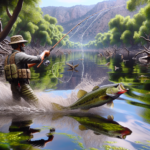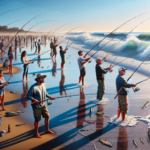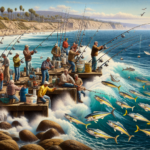Casting for Bass in California’s Delta Waters

Introduction
Did you know that California’s Delta waters are home to some of the best bass fishing in the United States? Whether you’re a seasoned angler or a novice looking to cast your first line, the Delta offers a unique and rewarding fishing experience. This article will guide you through everything you need to know about casting for bass in California’s Delta waters, from the best fishing techniques and gear to the top fishing spots and seasonal considerations.
Why does this matter? For many, fishing is more than just a hobby; it’s a way to connect with nature, relax, and even compete. Understanding the intricacies of bass fishing in the Delta can significantly enhance your experience, making your trips more successful and enjoyable.
Background/Context
Historical or Cultural Significance
The California Delta, also known as the Sacramento-San Joaquin Delta, has a rich history that dates back to the Gold Rush era. It has long been a vital waterway for transportation, agriculture, and recreation. The Delta’s unique ecosystem supports a diverse range of wildlife, including various fish species, making it a popular destination for anglers.
Geographical Overview
The Delta is a vast network of waterways, covering approximately 1,100 square miles. It is characterized by its intricate maze of rivers, sloughs, and channels, which create a dynamic and ever-changing environment. The region’s climate is Mediterranean, with hot, dry summers and mild, wet winters, providing ideal conditions for bass fishing year-round.
Key Points/Details
Fishing Techniques
Technique Overview
When it comes to bass fishing in the Delta, several techniques stand out:
- Topwater Fishing: This technique involves using lures that float on the water’s surface, mimicking prey like frogs or insects. It’s particularly effective during early morning or late evening.
- Flipping and Pitching: These techniques are ideal for fishing in heavy cover, such as weeds or submerged structures. They involve short, precise casts to place the bait accurately.
- Crankbait Fishing: Crankbaits are lures designed to dive to specific depths, making them perfect for covering large areas quickly.
When and Where to Use
Each technique has its optimal conditions:
- Topwater Fishing: Best used in shallow waters during low-light conditions.
- Flipping and Pitching: Effective in areas with dense vegetation or underwater structures.
- Crankbait Fishing: Ideal for open waters and when fish are scattered.
Recommended Gear
For a successful bass fishing trip in the Delta, consider the following gear:
- Rods: Medium-heavy to heavy rods for flipping and pitching; medium rods for topwater and crankbait fishing.
- Reels: Baitcasting reels for precision and control.
- Lines: Braided lines for heavy cover; fluorocarbon lines for clear water.
- Lures: Topwater frogs, jigs, and crankbaits.
Species Information
Species Overview
The Delta is home to several bass species, including:
- Largemouth Bass: Prefers shallow, weedy areas and is most active during warmer months.
- Smallmouth Bass: Found in rocky areas and deeper waters, especially during cooler months.
- Striped Bass: Migratory species that can be found in both freshwater and saltwater areas of the Delta.
Best Practices
To successfully catch bass in the Delta:
- Understand Seasonal Behavior: Bass behavior changes with the seasons, so adjust your techniques accordingly.
- Use Appropriate Gear: Match your gear to the specific conditions and species you’re targeting.
- Be Patient and Observant: Pay attention to water conditions, weather, and fish activity.
Location Information
Top Fishing Spots
Some of the best fishing spots in the Delta include:
- Franks Tract: Known for its abundant largemouth bass population.
- Big Break: Offers excellent opportunities for both largemouth and striped bass.
- Old River: A prime location for smallmouth bass.
Regulations and Licenses
Before you head out, make sure you’re aware of local fishing regulations:
- Licenses: A valid California fishing license is required for anglers aged 16 and older.
- Catch Limits: Be aware of daily bag limits and size restrictions for each species.
- Seasonal Restrictions: Some areas may have seasonal closures or specific regulations to protect spawning fish.
Seasonal Considerations
Seasonal Variations
Fishing conditions in the Delta change throughout the year:
- Spring: Bass are more active as they prepare for spawning. Focus on shallow areas with warmer water.
- Summer: Early morning and late evening are the best times to fish due to high daytime temperatures.
- Fall: Bass feed aggressively to prepare for winter, making it an excellent time for crankbait fishing.
- Winter: Fish are less active and move to deeper waters. Slow down your presentation and use finesse techniques.
Best Times to Fish
The optimal times for bass fishing in the Delta are:
- Early Morning: Fish are more active and feeding.
- Late Evening: Cooler temperatures make fish more likely to bite.
- Overcast Days: Reduced light levels can make fish more aggressive.
Events and Tournaments
Event Overview
The Delta hosts several fishing events and tournaments throughout the year:
- California Delta Bass Tournament: A popular event attracting anglers from across the state.
- Delta Bass Derby: A family-friendly event with various categories and prizes.
Preparation Tips
To prepare for a fishing tournament:
- Practice: Spend time on the water to familiarize yourself with the area and refine your techniques.
- Gear Check: Ensure all your equipment is in good working order and suited to the conditions.
- Strategy: Develop a game plan based on current conditions and fish behavior.
Tips and Best Practices
General Tips
Here are some practical tips to enhance your bass fishing experience in the Delta:
- Stay Mobile: Don’t be afraid to move around and try different spots.
- Observe Nature: Pay attention to bird activity and other wildlife, as they can indicate fish presence.
- Be Patient: Fishing requires patience and persistence. Don’t get discouraged if you don’t catch fish right away.
Avoid Common Mistakes
Common mistakes to avoid include:
- Overlooking Weather Conditions: Weather can significantly impact fish behavior. Check forecasts and plan accordingly.
- Using the Wrong Gear: Match your gear to the specific conditions and species you’re targeting.
- Ignoring Local Regulations: Always follow local fishing regulations to avoid fines and protect the ecosystem.
Advanced Techniques
For more experienced anglers, consider these advanced techniques:
- Drop Shotting: A finesse technique that involves suspending a baited hook above a weight, ideal for targeting deep or pressured fish.
- Swimbait Fishing: Using large, realistic lures to target trophy-sized bass.
- Jigging: A versatile technique that can be used in various conditions to mimic prey movements.
Gear and Equipment Recommendations
Essential Gear
The essential gear for bass fishing in the Delta includes:
- Rods: Medium-heavy to heavy rods for flipping and pitching; medium rods for topwater and crankbait fishing.
- Reels: Baitcasting reels for precision and control.
- Lines: Braided lines for heavy cover; fluorocarbon lines for clear water.
- Lures: Topwater frogs, jigs, and crankbaits.
Optional Gear/Upgrades
Consider these additional items to enhance your fishing experience:
- Fish Finder: Helps locate fish and underwater structures.
- Polarized Sunglasses: Reduces glare and helps spot fish in the water.
- Tackle Box: Keeps your gear organized and easily accessible.
Where to Buy or Rent
You can purchase or rent fishing gear from local shops or online stores:
- Local Shops: Delta Bait & Tackle, Fisherman’s Warehouse.
- Online Stores: Bass Pro Shops, Tackle Warehouse.
Safety and Conservation
Safety Tips
Ensure a safe fishing trip by following these tips:
- Check Weather Conditions: Always check the weather forecast before heading out.
- Wear a Life Jacket: Especially important when fishing from a boat.
- Stay Hydrated: Bring plenty of water, especially during hot weather.
Conservation Practices
Help protect the Delta’s ecosystem by practicing sustainable fishing:
- Catch and Release: Release fish that you don’t plan to keep to maintain healthy populations.
- Respect Wildlife: Avoid disturbing local wildlife and their habitats.
- Follow Regulations: Adhere to local fishing regulations to protect the ecosystem.
Planning Your Trip
Accommodations
Consider staying at these places near the Delta:
- Hotels: Best Western Plus Delta Inn & Suites, Hampton Inn & Suites Pittsburg.
- Campgrounds: Brannan Island State Recreation Area, Delta Meadows River Park.
Travel Tips
Here are some tips for getting to the Delta:
- By Car: The Delta is accessible via major highways like I-5 and Highway 4.
- By Boat: Several marinas offer boat rentals and launch facilities.
- Public Transportation: Limited options are available, so a car is recommended.
Additional Activities
If you have some non-fishing time, consider these activities:
- Wine Tasting: Visit local wineries in the Lodi wine region.
- Bird Watching: The Delta is a prime spot for bird enthusiasts.
- Hiking and Biking: Explore the area’s scenic trails.
Frequently Asked Questions (FAQs)
What is the best time of year to fish for bass in the Delta?
The best time to fish for bass in the Delta is during the spring and fall when fish are more active and feeding aggressively.
Do I need a fishing license to fish in the Delta?
Yes, a valid California fishing license is required for anglers aged 16 and older.
What are the top fishing spots in the Delta?
Some of the top fishing spots include Franks Tract, Big Break, and Old River.
What gear do I need for bass fishing in the Delta?
Essential gear includes medium-heavy to heavy rods, baitcasting reels, braided and fluorocarbon lines, and various lures like topwater frogs, jigs, and crankbaits.
Conclusion
Casting for bass in California’s Delta waters offers a unique and rewarding experience for anglers of all skill levels. By understanding the best techniques, gear, and locations, you can significantly enhance your chances of success. Remember to follow local regulations, practice sustainable fishing, and prioritize safety to ensure a memorable and enjoyable trip. So grab your gear, head to the Delta, and start casting for that trophy bass!
Whether you’re looking to master a new technique, explore a new fishing spot, or prepare for a tournament, this guide has you covered. Happy fishing!




